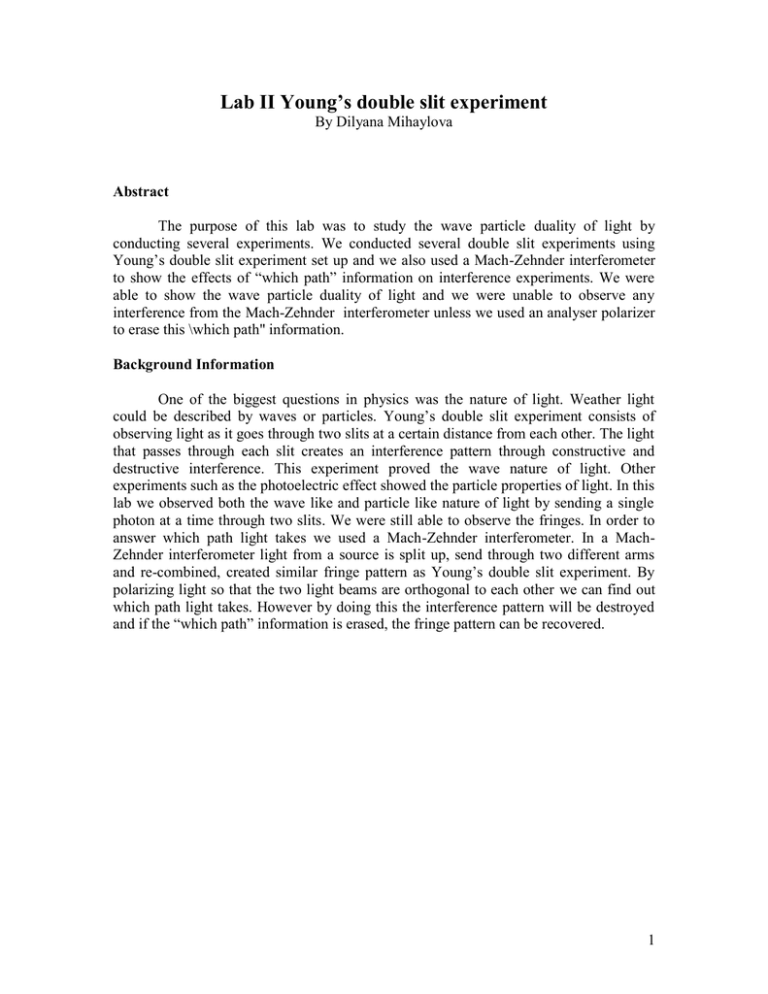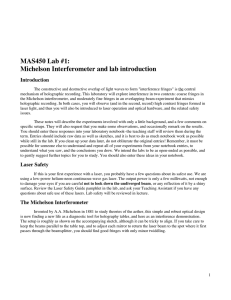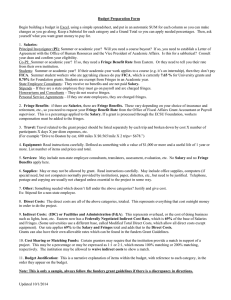Lab II Young`s double slit experiment
advertisement

Lab II Young’s double slit experiment By Dilyana Mihaylova Abstract The purpose of this lab was to study the wave particle duality of light by conducting several experiments. We conducted several double slit experiments using Young’s double slit experiment set up and we also used a Mach-Zehnder interferometer to show the effects of “which path” information on interference experiments. We were able to show the wave particle duality of light and we were unable to observe any interference from the Mach-Zehnder interferometer unless we used an analyser polarizer to erase this \which path" information. Background Information One of the biggest questions in physics was the nature of light. Weather light could be described by waves or particles. Young’s double slit experiment consists of observing light as it goes through two slits at a certain distance from each other. The light that passes through each slit creates an interference pattern through constructive and destructive interference. This experiment proved the wave nature of light. Other experiments such as the photoelectric effect showed the particle properties of light. In this lab we observed both the wave like and particle like nature of light by sending a single photon at a time through two slits. We were still able to observe the fringes. In order to answer which path light takes we used a Mach-Zehnder interferometer. In a MachZehnder interferometer light from a source is split up, send through two different arms and re-combined, created similar fringe pattern as Young’s double slit experiment. By polarizing light so that the two light beams are orthogonal to each other we can find out which path light takes. However by doing this the interference pattern will be destroyed and if the “which path” information is erased, the fringe pattern can be recovered. 1 Experimental Setup The Young double slit setup includes a laser beam from a 633nm, 5mW HeNe laser which goes through a pinhole and a lens. After that light goes through two slits, each of which was 10microns, and they are 90 microns apart. The fringes behind the double slit can be observed on a screen or a camera. We used an EMCCD camera. (Figure 1) There was also a stand in front of the double slit where we could place attenuators. The beam splitter was used to send light from the HeNe laser to the other set up. We used an image software ImageJ to plot the cross-section of the images we took. Figure 1. Young’s Double split experimental set up The Mach-Zehnder interferometer setup uses the same HeNe laser as an excitation source. The light goes through a linear polarizer with 45 degree output polarization and polarizing beam splitter. After that the light travels through two separate arms and is connected again through a non polarizing beam splitter. Then the laser beam goes through a polarizer and the fringes can be observed by using a camera or a screen. (Figure 2) Figure 2. Mach-Zehnder interferometer 2 Procedure and Results Part I Young’s Double Slit Experiment We took images of the fringes and single photons observed with double slit set up with the EMCCD camera. Using the known relationships: N /s (number of photons per second) = P*λ/h*c N/m (number of photons per meter) = P*λ/h*c2 Where P is the power of the laser, λ is the wavelength, h is Planck’s constant and c is the speed of light we were able to calculate the additional filters needed in order to attenuated the laser light from the single photon level. First we looked at the fringes from light that was not attenuated to a single photon level (Figure 3). The image shows the fringe pattern for attenuation of 3 orders of magnitude and its corresponding cross section. The fringes observed, show the wave property of light. There is no maximum in the center of the fringes because the slits are carved in a lithographic plate and the light reflected from it interferes to distort the pattern. 480 440 400 320 Cross Section Distance (pixels) 360 280 240 200 160 120 80 40 0 50 100 150 200 0 Gray Value Figure 3.a Figure 3.b Figure 3. Image of the fringes observed with 3 orders of attinuation (left) and its corresponding cross section (right). With laser power of 1.25µW 3 After we observed the fringes for the unattinuated laser light we added more filters infront of the double slit until we had attinuation of seven orders of magnituted which was the calculated necessary attinuation on order to have single photons. We took several images for different camera accumulation times. All images were taken with maximum gain. First we took an image with accumulation time .1s. (Figure 4.a) We were not able to observe fringes but after the image was color inverted you can observe dark pixels where the camera detected individual photons. This shows the particle like nature of light. After that without changing the order of attinuation we increased the accusition time to 1 second and took another image. Once again we were able to observe faint fringes (Figure 5.a) This supports the wave theory of light. Figures 4 and 5 together show the wave particle duality of light. 480 440 400 320 Cross section Distance (pixels) 360 280 240 200 160 120 80 40 140 120 100 80 60 40 20 0 0 Gray Value Figure 4.a Figure 4.b Image of attinuated laser light with 7orders of magnitute attinuation taken for .1s (left) with its corresponding cross section (right) . Note that the EMCCD camera image is inverted. 4 480 440 400 320 Cross Section Distance (pixels) 360 280 240 200 160 120 80 40 0 50 100 150 200 0 Grey Value Figure 5.a Figure 5.b Figure 5. Inverted image of attinuated laser light with 7 orders of magnitute attinuation and 1second accumulation (left) with corresponding cross section (right) Part II Mach-Zehnder experiment We also took images with the EMCCD camera of the output of the Mach-Zehnder interferometer. First we took images with different orders of magnitude attenuation and with different acquisition levels. In order to show the properties of “which way information” we took 36 images while rotating the polarizer by ten degrees starting from zero. For some polarizer angle we were able to take a clear image of the fringes while for others the images are very blurry. For angles where we can not observe the fringes we have “which path information” which means that we know which path the photons chose. This demonstrates the particle nature of light. For angles where we can observe the fringes we see the wave nature of light but at the same time we do not know which path the photons took. a. zero degrees b. sixty degrees c. eighty degrees d. 170 degrees Figure6. Fringe visibility for different angle of polarization. For zero degrees (a) there are no fringes so we know “which path information”. For sixty degrees we can see clear fringes (b). The power of the laser was 6µW. 5 We also aligned the Mach Zehnder interferometer by removing the two mirrors and two beam splitters. After that we placed them back in the set up and tried to align them in such a manner so that when the two beams are recombined at the second beamsplitter they overlap completely and create and interference pattern both at close and far distances. Part 3 Calculating the fringe visibility The fringe visibility can be calculated using the cross section of the images taken with the EMCCD camera and using the formula where N refers to the maximum and minimum of the gray scale. For example in the Mach Zehnder interferometer at polarizer angle of zero degrees will have a no definite fringe visibility while at a polarizer angle of sixty degrees there is a fringe visibility of 58% and the periodic structure of the fringes is much more noticeable (Figure 7.b) Cross Section 480 440 400 360 320 280 240 200 160 Distance (pixels) Distance (pixels) Figure 7.a 120 80 0 160 140 120 100 80 60 40 20 0 40 480 440 400 360 320 280 240 200 160 80 120 0 Gray scale 140 120 100 80 60 40 20 0 40 Grey Scale Cross Section Figure 7.b Figure7 Cross section of Mach Zehnder intereferometer data with polarizer angle of zero degrees (a) and sixty degrees (b). 6 Conclusion In this lab we used Young’s double slit experiment with attenuated laser light to show that light behaves both as a particle and a wave. We also used a Mach-Zehnder interferometer to study the effects of which path information. We were able to observe the disappearance of the fringes for angles of the polarizer at which the which path information is present. We were also able to calculate the fringe visibility by using the cross sections of the different images. References 1. M. B. Schneider and I. A. LaPuma, “A simple experiment for discussion of quantum interference and which-way measurement,” American Journal of Physics, vol. 70, no. 3, p. 266, 2002. 2. Chitraleema Chakraborty, “Nature of photon: Particle or a wave?” 12, 4, 2012 7



